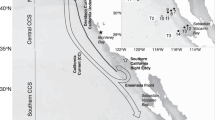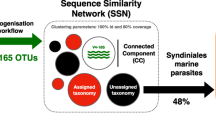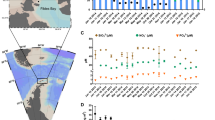Abstract
A marine symbiosis has been recently discovered between prymnesiophyte species and the unicellular diazotrophic cyanobacterium UCYN-A. At least two different UCYN-A phylotypes exist, the clade UCYN-A1 in symbiosis with an uncultured small prymnesiophyte and the clade UCYN-A2 in symbiosis with the larger Braarudosphaera bigelowii. We targeted the prymnesiophyte–UCYN-A1 symbiosis by double CARD-FISH (catalyzed reporter deposition-fluorescence in situ hybridization) and analyzed its abundance in surface samples from the MALASPINA circumnavigation expedition. Our use of a specific probe for the prymnesiophyte partner allowed us to verify that this algal species virtually always carried the UCYN-A symbiont, indicating that the association was also obligate for the host. The prymnesiophyte–UCYN-A1 symbiosis was detected in all ocean basins, displaying a patchy distribution with abundances (up to 500 cells ml−1) that could vary orders of magnitude. Additional vertical profiles taken at the NE Atlantic showed that this symbiosis occupied the upper water column and disappeared towards the Deep Chlorophyll Maximum, where the biomass of the prymnesiophyte assemblage peaked. Moreover, sequences of both prymnesiophyte partners were searched within a large 18S rDNA metabarcoding data set from the Tara-Oceans expedition around the world. This sequence-based analysis supported the patchy distribution of the UCYN-A1 host observed by CARD-FISH and highlighted an unexpected homogeneous distribution (at low relative abundance) of B. bigelowii in the open ocean. Our results demonstrate that partners are always in symbiosis in nature and show contrasted ecological patterns of the two related lineages.
Similar content being viewed by others
Log in or create a free account to read this content
Gain free access to this article, as well as selected content from this journal and more on nature.com
or
References
Bombar D, Heller P, Sanchez-Baracaldo P, Carter BJ, Zehr JP . (2014). Comparative genomics reveals surprising divergence of two closely related strains of uncultivated UCYN-A cyanobacteria. ISME J 8: 2530–2542.
Brown MT, Landing WM, Measures CI . (2005). Dissolved and particulate Fe in the western and central North Pacific: results from the 2002 IOC cruise. Geochem Geophys Geosyst 6: Q10001.
Capone DG, Burns JA, Montoya JP, Subramaniam A, Mahaffey C, Gunderson T et al. (2005). Nitrogen fixation by Trichodesmium spp.: an important source of new nitrogen to the tropical and subtropical North Atlantic Ocean. Glob Biogeochem Cycles 19: GB2024.
Carpenter EJ, Foster RA . (2002) Marine cyanobacterial symbiosis. In: Rai AN, Bergman B, Rasmussen U (eds). Cyanobacteria in Symbiosis. Kluwer Academic Publishers: : Dordrecht, The Netherlands, pp 11–17.
Church MJ, Bjo KM, Karl DM, Saito MA, Zehr JP . (2008). Regional distributions of nitrogen-fixing bacteria in the Pacific Ocean. Limnol Oceanogr 53: 63–77.
Church MJ, Jenkins BD, Karl DM, Zehr JP . (2005). Vertical distributions of nitrogen-fixing phylotypes at stn ALOHA in the oligotrophic North Pacific Ocean. Aquat Microb Ecol 38: 3–14.
Church MJ, Mahaffey C, Letelier RM, Lukas R, Zehr JP, Karl DM . (2009). Physical forcing of nitrogen fixation and diazotroph community structure in the North Pacific subtropical gyre. Glob Biogeochem Cycles 23: GB2020.
Cornejo-Castillo FM, Cabello AM, Salazar G, Sánchez-Baracaldo P, Lima-Mendez G, Hingamp P et al. Co-evolution and genome expression of closely related cyanobacterial symbionts originated during the late Cretaceous. (Submitted.
De Vargas C, Audic S, Henry N, Decelle J, Mahé F, Logares R et al. (2015). Eukaryotic plankton diversity in the sunlit ocean. Science 348: 1261605.
Dore JE, Letelier RM, Church MJ, Lukas R, Karl DM . (2008). Summer phytoplankton blooms in the oligotrophic North Pacific Subtropical Gyre: historical perspective and recent observations. Prog Oceanogr 76: 2–38.
Fernández-Castro B, Mouriño-Carballido B, Marañón E, Chouciño P, Gago J, Ramírez T et al. (2015). Important role of salt-finguers diffusivity for new nitrogen supply in oligotrophic ocean. Nat Commun (in press).
Foster RA, Carpenter EJ, Bergman B . (2006). Unicellular cyanobionts in open ocean dinoflagellates, radiolarians, and tintinnids: ultrastructural characterization and immuno-localization of phycoerythrin and nitrogenase. J Phycol 42: 453–463.
Foster RA, Kuypers MMM, Vagner T, Paerl RW, Musat N, Zehr JP . (2011). Nitrogen fixation and transfer in open ocean diatom-cyanobacterial symbioses. ISME J 5: 1484–1493.
Gaarder KR . (1954). Coccolithineae, Silicoflagellatae, Pterospermataceae and other forms from the “Michael Sars” North Atlantic Deep-Sea Expedition 1910. Report on the scientific results of the “Michael Sars” North Atlantic Deep-Sea Expedition. The Trustees of the Bergen museum: Bergen, Norway, pp 1–20.
Goebel NL, Turk KA, Achilles KM, Paerl R, Hewson I, Morrison AE et al. (2010). Abundance and distribution of major groups of diazotrophic cyanobacteria and their potential contribution to N2 fixation in the tropical Atlantic Ocean. Environ Microbiol 12: 3272–3289.
Grasshoff K, Ehrhardt M, Kremling K . (1999) Methods of Seawater Analysis, 3rd edn. Wiley-VCH: : Weinheim, Germany.
Hagino K, Onuma R, Kawachi M, Horiguchi T . (2013). Discovery of an endosymbiotic nitrogen-fixing cyanobacterium UCYN-A in Braarudosphaera bigelowii (Prymnesiophyceae). PLoS One 8: e81749.
Hagino K, Takano Y, Horiguchi T . (2009). Pseudo-cryptic speciation in Braarudosphaera bigelowii (Gran and Braarud) Deflandre. Mar Micropaleontol 72: 210–221.
Hulburt EM . (1962). Phytoplankton in the southwestern Sargasso Sea and North Equatorial Current. Limnol Oceanogr 7: 307–315.
Jacquet S, Lennon JF, Marie D, Vaulot D . (1998). Picoplankton population dynamics in coastal waters of the northwestern Mediterranean Sea. Limnol Oceanogr 43: 1916–1931.
Jacquet S, Partensky F, Lennon JF, Vaulot D . (2001). Diel patterns of growth and division in marine picoplankton in culture. J Phycol 37: 357–369.
Karsenti E, Acinas SG, Bork P, Bowler C, De Vargas C, Raes J et al. (2011). A holistic approach to marine eco-systems biology. PLoS Biol 9: e1001177.
Konno S, Harada N, Jordan RW . (2007). Living Braarudosphaera bigelowii (Gran & Braarud) Deflandre in the Bering Sea. J Nannoplankt Res 29: 78–87.
Krupke A, Lavik G, Halm H, Fuchs BM, Amann RI, Kuypers MMM . (2014a). Distribution of a consortium between unicellular algae and the N2 fixing cyanobacterium UCYN-A in the North Atlantic Ocean. Environ Microbiol 16: 3153–3167.
Krupke A, Mohr W, LaRoche J, Fuchs BM, Amann RI, Kuypers MMM . (2014b). The effect of nutrients on carbon and nitrogen fixation by the UCYN-A-haptophyte symbiosis. ISME J 9: 1635–1647.
Krupke A, Musat N, LaRoche J, Mohr W, Fuchs BM, Amann RI et al. (2013). In situ identification and N2 and C fixation rates of uncultivated cyanobacteria populations. Syst Appl Microbiol 36: 259–271.
Langlois RJ, Hümmer D, LaRoche J . (2008). Abundances and distributions of the dominant nifH phylotypes in the Northern Atlantic Ocean. Appl Environ Microbiol 74: 1922–1931.
Langlois RJ, Mills MM, Ridame C, Croot P, LaRoche J . (2012). Diazotrophic bacteria respond to Saharan dust additions. Mar Ecol Prog Ser 470: 1–14.
Latasa M . (2014). A simple method to increase sensitivity for RP-HPLC phytoplankton pigment analysis. Limnol Oceanogr Methods 12: 46–53.
Mahowald NM, Engelstaedter S, Luo C, Sealy A, Artaxo P, Benitez-Nelson C et al. (2009). Atmospheric iron deposition: global distribution, variability, and human perturbations. Ann Rev Mar Sci 1: 245–278.
Man-Aharonovich D, Kress N, Zeev EB, Berman-Frank I, Béjà O . (2007). Molecular ecology of nifH genes and transcripts in the eastern Mediterranean Sea. Environ Microbiol 9: 2354–2363.
Mazard SL, Fuller NJ, Orcutt KM, Bridle O, Scanlan DJ . (2004). PCR analysis of the distribution of unicellular cyanobacterial diazotrophs in the Arabian Sea. Appl Environ Microbiol 70: 7355–7364.
Moisander PH, Beinart RA, Hewson I, White AE, Johnson KS, Carlson CA et al. (2010). Unicellular cyanobacterial distributions broaden the oceanic N2 fixation domain. Science 327: 1512–1514.
Moore MC, Mills MM, Achterberg EP, Geider RJ, LaRoche J, Lucas MI et al. (2009). Large-scale distribution of Atlantic nitrogen fixation controlled by iron availability. Nat Geosci 2: 867–871.
Moreno-Ostos E . (2012). Libro blanco de métodos y técnicas de trabajo oceanográfico. Expedición de circunnavegación Malaspina 2010: Cambio global y exploración de la biodiversidad del océano. CSIC: Madrid, Spain.
Nakayama T, Kamikawa R, Tanifuji G, Kashiyama Y, Ohkouchi N, Archibald JM et al. (2014). Complete genome of a nonphotosynthetic cyanobacterium in a diatom reveals recent adaptations to an intracellular lifestyle. Proc Natl Acad Sci USA 111: 11407–11412.
Pernthaler A, Pernthaler J, Amann R . (2004). Sensitive multi-color fluorescence in situ hybridization for the identification of environmental microorganisms. Mol Microb Ecol Man 3: 711–726.
Raes E, Waite A, McInnes A, Olsen H, Nguyen H, Hardman-Mountford N et al. (2014). Changes in latitude and dominant diazotrophic community alter N2 fixation. Mar Ecol Prog Ser 516: 85–102.
Rai AN, Bergman B, Rasmussen U . (2002) Cyanobacteria in Symbiosis. Kluwer Academic Publishers: : Secaucus, NJ, USA.
Reynolds CS . (1997) Vegetation Processes in the Pelagic: A Model for Ecosystem Theory. International Ecology Institute: : Oldendorf/Luhe, Germany.
Ridame C, Guieu C . (2002). Saharan input of phosphate to the oligotrophic water of the open western Mediterranean Sea. Limnol Oceanogr 47: 856–869.
Robidart JC, Church MJ, Ryan JP, Ascani F, Wilson ST, Bombar D et al. (2014). Ecogenomic sensor reveals controls on N2-fixing microorganisms in the North Pacific Ocean. ISME J 8: 1175–1185.
Shi XL, Marie D, Jardillier L, Scanlan DJ, Vaulot D . (2009). Groups without cultured representatives dominate eukaryotic picophytoplankton in the oligotrophic South East Pacific Ocean. PLoS One 4: e7657.
Shushkina EA, Vinogradov ME, Lebedeva LP, Anokhina LL . (1997). Productivity characteristics of epipelagic communities of the world’s oceans. Oceanology 37: 346–353.
Simon N, Campbell L, Ornolfsdottir E, Groben R, Guillou L, Lange M et al. (2000). Oligonucleotide probes for the identification of three algal groups by dot blot and fluorescent whole-cell hybridization. J Eukaryot Microbiol 47: 76–84.
Sohm JA, Hilton JA, Noble AE, Zehr JP, Saito MA, Webb EA . (2011a). Nitrogen fixation in the South Atlantic Gyre and the Benguela Upwelling system. Geophys Res Lett 38: L16608.
Sohm JA, Webb EA, Capone DG . (2011b). Emerging patterns of marine nitrogen fixation. Nat Rev Microbiol 9: 499–508.
Thompson A, Carter BJ, Turk-Kubo K, Malfatti F, Azam F, Zehr JP . (2014). Genetic diversity of the unicellular nitrogen-fixing cyanobacteria UCYN-A and its prymnesiophyte host. Environ Microbiol 16: 3238–3249.
Thompson AW, Foster RA, Krupke A, Carter BJ, Musat N, Vaulot D et al. (2012). Unicellular cyanobacterium symbiotic with a single-celled eukaryotic alga. Science 337: 1546–1550.
Tripp HJ, Bench SR, Turk KA, Foster RA, Desany BA, Niazi F et al. (2010). Metabolic streamlining in an open-ocean nitrogen-fixing cyanobacterium. Nature 464: 90–94.
Tyrrell T, Marañón E, Poulton AJ, Bowie AR, Harbour DS, Woodward EMS . (2003). Large-scale latitudinal distribution of Trichodesmium spp. in the Atlantic Ocean. J Plankton Res 25: 405–416.
Yentsch CS, Menzel DW . (1963). A method for the determination of phytoplankton chlorophyll and phaeophytin by fluorescence. Deep Sea Res Oceanogr Abstr 10: 221–231.
Zehr JP, Bench SR, Carter BJ, Hewson I, Niazi F, Shi T et al. (2008). Globally distributed uncultivated oceanic N2-fixing cyanobacteria lack oxygenic photosystem II. Science 322: 1110–1112.
Acknowledgements
Financial support has been provided by the Spanish Ministry of Economy and Competitivity through project Consolider-Ingenio Malaspina 2010 (CSD2008-00077) to CMD, FLAME (CGL2010-16304) to RM, and PANGENOMICS (CGL2011-26848/BOS) to SGA. AMC was recipient of a Spanish FPI grant (BES-2009-027194). We thank all the technicians, researchers, crew and chief scientists of the different cruises for collaboration. We thank M Galindo and P de la Fuente for nutrient analysis, R Logares for sequence advice, R Simó and JM Gasol for useful comments on the manuscript and B Fernández-Castro and B Mouriño for sharing unpublished data.
Author information
Authors and Affiliations
Corresponding authors
Ethics declarations
Competing interests
The authors declare no conflict of interest.
Additional information
Supplementary Information accompanies this paper on The ISME Journal website
Supplementary information
Rights and permissions
About this article
Cite this article
Cabello, A., Cornejo-Castillo, F., Raho, N. et al. Global distribution and vertical patterns of a prymnesiophyte–cyanobacteria obligate symbiosis. ISME J 10, 693–706 (2016). https://doi.org/10.1038/ismej.2015.147
Received:
Revised:
Accepted:
Published:
Issue date:
DOI: https://doi.org/10.1038/ismej.2015.147
This article is cited by
-
Symbiotic UCYN-A strains co-occurred with El Niño, relaxed upwelling, and varied eukaryotes over 10 years off Southern California
ISME Communications (2023)
-
Top-down control on major groups of global marine diazotrophs
Acta Oceanologica Sinica (2022)
-
Global distribution patterns of marine nitrogen-fixers by imaging and molecular methods
Nature Communications (2021)
-
UCYN-A/haptophyte symbioses dominate N2 fixation in the Southern California Current System
ISME Communications (2021)
-
Unusual marine cyanobacteria/haptophyte symbiosis relies on N2 fixation even in N-rich environments
The ISME Journal (2020)



